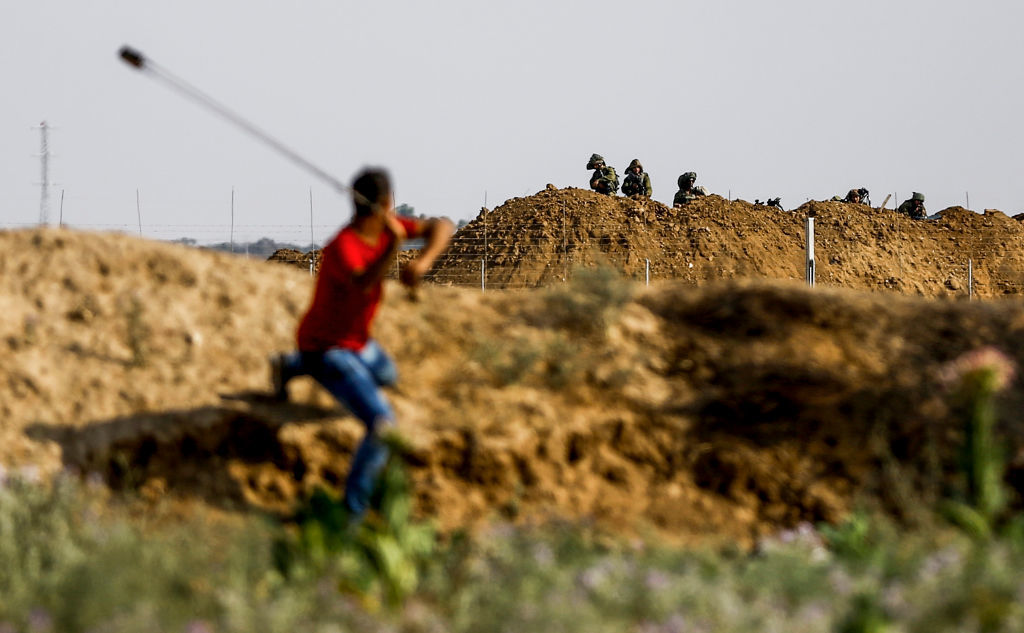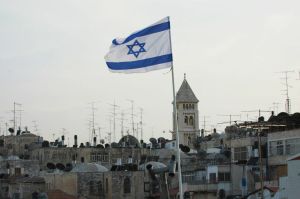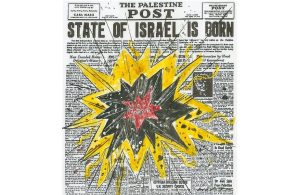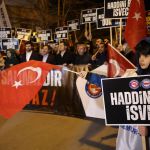The killing of dozens of Gazans in today’s assault on the Gaza-Israel border was not a surprise, but a strategy—certainly for Hamas, and thus inevitably for Israel. Hamas, which controls Gaza and wants to replace Israel with a Islamist caliphate, has incited its captive subjects and organized a six-week sequence of mass protests. Hamas promised that the last of these, timed for the day after Israelis had celebrated the seventieth anniversary of Israel’s founding and the transfer of the American embassy to Jerusalem, would breach the fence, invade Israel, and launch a ‘March of Return’. Both sides understood the script, and spoke with corresponding fluency.
‘Youngsters of the Palestinian revolution,’ a Hamas video called, ‘Jerusalem is waiting for your revolution. So show it your firm determination in battle.’
‘Hamas plans to carry out a massacre in Israel,’ the Israel Defence Forces said on Sunday, ‘The IDF will not let them.’
In the event, Hamas moved the protest up by a day, to capitalize on coverage while the world’s media were covering the embassy opening. This tactic worked, as it always does. When it came to battle, the IDF obliged with a ‘massacre’ on the other side of the border fence. The Israeli-Palestinian conflict is a war of imagery as well as a war of demography, weaponry, and ideology, and both sides know the advantages of playing David to the other’s Goliath. So tonight’s news and tomorrow’s newspapers will juxtapose images of the Jerusalem embassy—the smug Israeli government and its friends in the Trump administration—with images of burning tires, slingshots, dead bodies, and snipers. But what of the strategy?
The narrative of eternally martyred Palestinians and vindictive Jews plays broadly well in Europe. But it does nothing for the people of Gaza, or the Palestinians in Lebanon and Jordan. The strategy of ‘resistance’—terrorism against civilians—secured the world’s attention for the PLO after 1968, when Yasser Arafat was in his telegenic phase and hijacking planes was only slightly less chic than jet travel itself. But the strategy turned out to be disastrous to the Palestinian cause, because permanent resistance, it turns out, means permanent defeat. A playbook that contains only one play is, it turns out, not a game-changer.
Today’s deaths failed to make a dent in the fence. The IDF is an immovable object, and the Palestinians are, as it always turns out, a resistible force. The killings will make a small dent in the awareness of a global audience, but the meaning of that impact has changed since the Seventies, and changed again since the Arab Spring and the Syrian Civil War.
The world suffers from terrorism fatigue and a surfeit of images. The war of images may favor the Palestinians, but since 2000, American public opinion has swung strongly towards Israel. The fiftieth anniversary of the Six-Day War and the ‘occupation’ have come and gone. And with Iranian influence on the rise across the Middle East, the Palestinians have found that their fellow Sunnis are, yet again, selling them out for strategic reasons. The road to Jerusalem no longer runs through Gaza, or even Ramallah, but through Riyadh. Hamas’ strategy is not just an attempt to break the Israeli-Egyptian blockade on Gaza. It is a plea for relevance, funded in part by Iran.
We are told that we live in a world of images, and that images shape reality. The people who tell us this tend to work in the media—that is, they are manufacturers of images—or in the media-friendly departments of our universities. Certainly, images mean a lot. But they might not determine reality as comprehensively as we think. The Palestinians can rain on the parade of the Israelis’ anniversary celebrations, but their March of Return is going nowhere. Meanwhile, there is no doubt at all that it is the Israelis who are winning the war of reality.
Israel’s grip on Judea and Samaria (the ‘West Bank’) has never been tighter. For more than a decade, the Palestinian national movement has been two movements, the PLO in Ramallah and Hamas in Gaza, in a state of civil war. The moving of the American embassy to Jerusalem leaves room for the old peace-processing paradigm—the new ‘embassy’ is the old consulate, which is well inside the western, Jewish side of the city—but it symbolizes the defeat of the Palestinian national movement. Even John Sullivan, the State Department’s representative at the embassy opening, has called its transfer from Tel Aviv a ‘long overdue recognition of reality’.
Sullivan also called the move an ‘essential’ precondition for ‘creating a roadmap for peace in the region’. But the region has long since torn up the map. And while Benjamin Netanyahu will quite probably pocket the embassy gift without having to reciprocate with a little peace-processing, the Trump dividend cannot secure Israel’s future. The unfinished business of 1967 and 1948 and 1917—the Six-Day War, the Israeli War of Independence and the Balfour Declaration—remains to be settled. While Zionism was creating the Israelis, it also created the Palestinians.
It is true that the Palestinian ‘situation’, as Israelis euphemize it, can be ‘managed’. But piecemeal settlements and policing actions will never resolve the conflict, even though dividing and ruling, and economic incentives too, can all ameliorate it. Sooner or later, Israel will have to come up with a plan, either to incorporate the Arabs of Judea and Samaria as full citizens; or as Israel did in Gaza, to contract its borders in order to exclude them.
Today’s events suggest that incorporation may be less of a risk than exclusion. If so, then a Palestinian victory in the war of images will, once again, hasten the defeat of Palestinian nationalism.


















